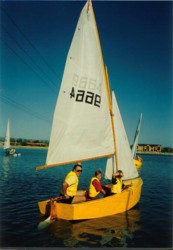Related Research Articles

Dinghy sailing is the activity of sailing small boats by using five essential controls:
The Mirror is a popular sailing dinghy with more than 70,000 built.

The Heron Dinghy is a dinghy designed by Jack Holt of the United Kingdom as the Yachting World Cartopper. The Heron dinghy was designed to be built by a home handyman out of marine ply over a timber frame, but can now also be constructed from marine ply using a stitch and glue technique or from Fibreglass. Modern dinghies will usually have built in buoyancy tanks, older craft will have bags or retrofitted tanks.

The Optimist, also known as the ‘opti’, 'oppie', 'opy' or 'bathtub' is a small, single-handed sailing dinghy intended for use by children up to the age of 15. Contemporary boats are usually made of fibreglass, although wooden boats are still built.

The Europe is a one-person dinghy designed in Belgium in 1960 by Alois Roland as a class legal Moth dinghy. The design later changed into its own one-design class.

The Flying Dutchman (FD) is a 20-foot one-design high-performance two-person monohull racing dinghy. Developed in the early 1950s in the Netherlands, its large sail area per unit weight allow it to plane easily when sailing upwind. The boat utilizes a trapeze harness for the crew and hiking straps for the skipper to counterbalance the wind force on its sails. It made its Olympic debut at the 1960 Olympic Games.

The International 505 is a One-Design high-performance two-person monohull planing sailing dinghy, with spinnaker, utilising a trapeze for the crew.

The Byte is a small one-design sailing dinghy sailed by one person. It was designed by Canadian Ian Bruce, who also commissioned and marketed the Laser.

The Fireball is a British sailing dinghy that was designed by Peter Milne as a one-design racer and first built in 1962.

The 12 ft Skiff is a development dinghy class dating back to the early 20th century. It is sailed in Australia and New Zealand. It is 12 ft (3.7 m) in length, hence the name, and is a two-man boat. Both the crew and the helm are able to use the trapeze at the same time. It has an asymmetrical spinnaker and a jib, in addition to the mainsail.
Ian Douglas Ben Proctor, known as Ian Proctor, was a British designer of boats, both sailing dinghies and cruisers. He had more than one hundred designs to his credit, from which an estimate of at least 65,000 boats were built. His pioneering aluminium mast designs also revolutionised the sport of sailing.
The Pacer class of sailing dinghy, formerly known as the Puffin Pacer, was designed in the United Kingdom by Jack Holt. It was commissioned by Puffin Paints and Glues to be designed as sailing dinghy for use by families, so needing to be larger than their earlier Puffin dinghy. It has since become a popular learning and racing dinghy in Australia, Canada, the Netherlands, India and the UK. The name was changed in the UK early 1970s, although Australia continued to use the name until 1989, when they followed the UK in dropping the "puffin" and chose the wedge-tailed shearwater as the boat's symbol.
Iain Murray is an Australian sailor. He is most noted for his appearances in 12-Metre Class yachts in the 1983 and 1987 America's Cup regattas and his management of the 2013 America's Cup in San Francisco, California.
Jennifer Margaret Armstrong OAM is an Olympic sailor from New Zealand. After competing for her native country at the 1992 Olympics, she moved to Australia in 1996 and won a historic sailing gold for her adopted country at the 2000 Olympics.

The 125 is a 12 ft 6 in (3.81 m) two person intermediate sailing dinghy complete with main, jib, spinnaker and trapeze. The 125 class has a strong following within Australia with national titles being held every year around the country and local state associations. The class was originally designed as an intermediate class for developing skills with the jib, spinnaker and trapeze but has become popular from novice to experienced sailors.

The Impulse is an Australian sailing dinghy that was designed by Arthur Caldwell as a one-design racer and first built in 1975.

The Farr 3.7 is a one-person sailing dinghy designed by Bruce Farr in 1971. The design plans are sold by the 3.7 Class Owners Association and they are built by a mix of professionals and home built by amateurs. The 3.7 Class is recognised by Yachting New Zealand as a national class and yachts are sailed in New Zealand, Australia and Great Britain. Full sets of plans have been sold worldwide to a number of individuals with greatest numbers in Germany, Japan, USA, South Korea, Poland, France, Belgium.
Carlo Croce is an Italian former yacht racer who competed in the 1972 Summer Olympics and the 1976 Summer Olympics. He was born in Genoa, Italy.
The Flying Phantom Elite is a French hydrofoil catamaran sailing dinghy that was designed by Martin Fischer and draws on the work of Alex Udin, Franck Cammas and the Groupama sailing team. It is intended as a one-design racer and was first built in 2015.
The Flying Phantom Essentiel,, is a French hydrofoil catamaran sailing dinghy that was designed by Gonzalo Redondo and Martin Fischer and first built in 2017.
References
- ↑ "Dinghy Sports Flying Ant". Dinghy Sports Australia. Archived from the original on 10 July 2011. Retrieved 25 July 2009.
- ↑ "Australian Flying Ant Association". Yachte.com.au. Archived from the original on 6 February 2010. Retrieved 25 July 2009.
| This article about a type of ship or boat is a stub. You can help Wikipedia by expanding it. |